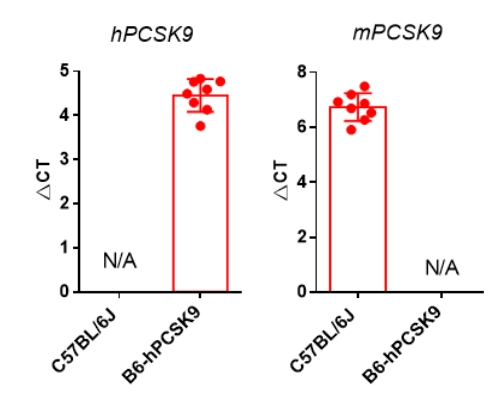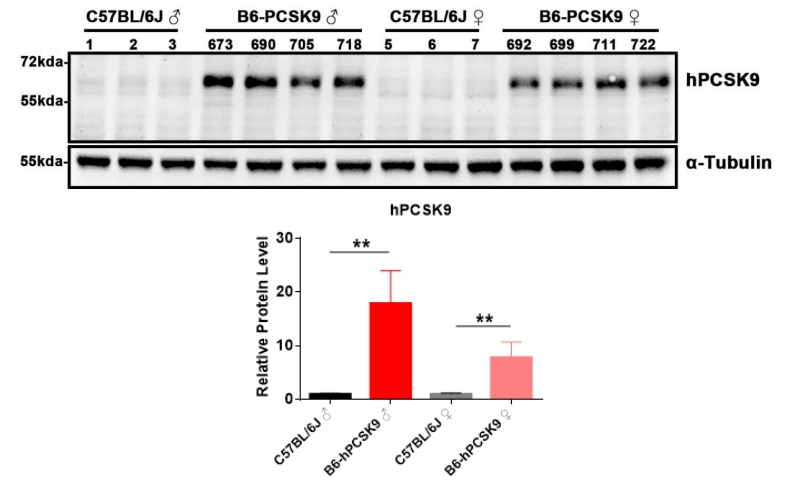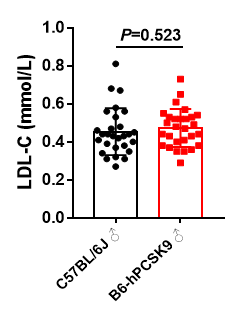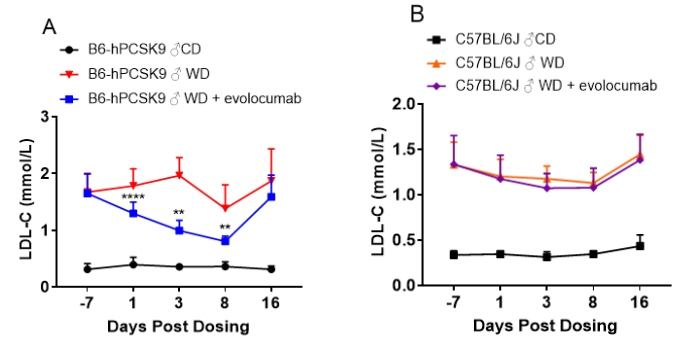Plasma LDL-C (low-density lipoprotein cholesterol) is cleared from the plasma mainly through the LDLR pathway. After LDL binds to LDLR, LDL and LDLR are internalized into clathrin-coated pits and degraded in the lysosome. Proprotein convertase subtilisin/kexin type 9 (PCSK9) is a known secretory factor mainly expressed in liver tissues which negatively regulates the expression level of LDLR on the cell membrane. Secreted PCSK9 binds to the LDLR and increases lysosomal degradation. PCSK9 gain-of-function mutations are related to familial hyperlipidemia, while PCSK9 loss-of-function mutations lead to a 15-28% reduction in LDL-C levels. Similarly, overexpression and deletion of PCSK9 in mice can down-regulate and up-regulate the expression level of LDLR, respectively, resulting in hyperlipidemia and hypolipidemia in the respective mouse lines. The B6-hPCSK9 mouse model expresses the human PCSK9 in place of the mouse gene, providing a valuable platform for the evaluation of therapeutics to modulate cholesterol through this pathway.
Study Design and Example Data
Liver hPCSK9 mRNA and protein expression

Fig 1. Human, but not murine, PCSK9 mRNA is expressed in the liver of B6-hPCSK9 mice (5 weeks old). Data are presented as Mean±SD,n=8.

Fig 2. hPCSK9 protein is detected in the liver of B6-hPCSK9 mice but not in the liver of C57BL/6JGpt mice (5 weeks old). Data are presented as Mean±SD,n=3~4. **,p<0.01 by unpaired t test.
Liver LDLR protein expression

Fig 3. No significant difference in liver LDLR expression between C57BL/6JGpt and B6-hPCSK9 mice (5 weeks old). Data are presented as Mean±SD,n=3~4.
Plasma LDL-C level

Fig 4. No significant difference in plasma LDL-C level between C57BL/6JGpt and B6-hPCSK9 mice (8 weeks old). Data are presented as Mean±SD,n=20. P=0.523 by unpaired t test.
Drug efficacy study

Fig 5. A single tail vein injection of evolocumab (20mpk) significantly reduces the plasma LDL-C level of western diet-fed B6-hPCSK9 mice, but no similar effect was observed in western diet-fed C57BL/6JGpt mice. Data are presented as Mean±SD,n=5~8。**, p<0.01; ***, p<0.001 Vs B6-hPCSK9+WD by unpaired t test.

Fig 6. 3 days after a single tail vein injection of evolocumab (20mpk), the expression level of liver LDLR in western diet-fed B6-hPCSK9 mice is significantly increased. Data are presented as Mean±SD,n=3~4。 **, p<0.05 Vs B6-hPCSK9+WD by one way ANOVA with Fisher`s LSD test.

